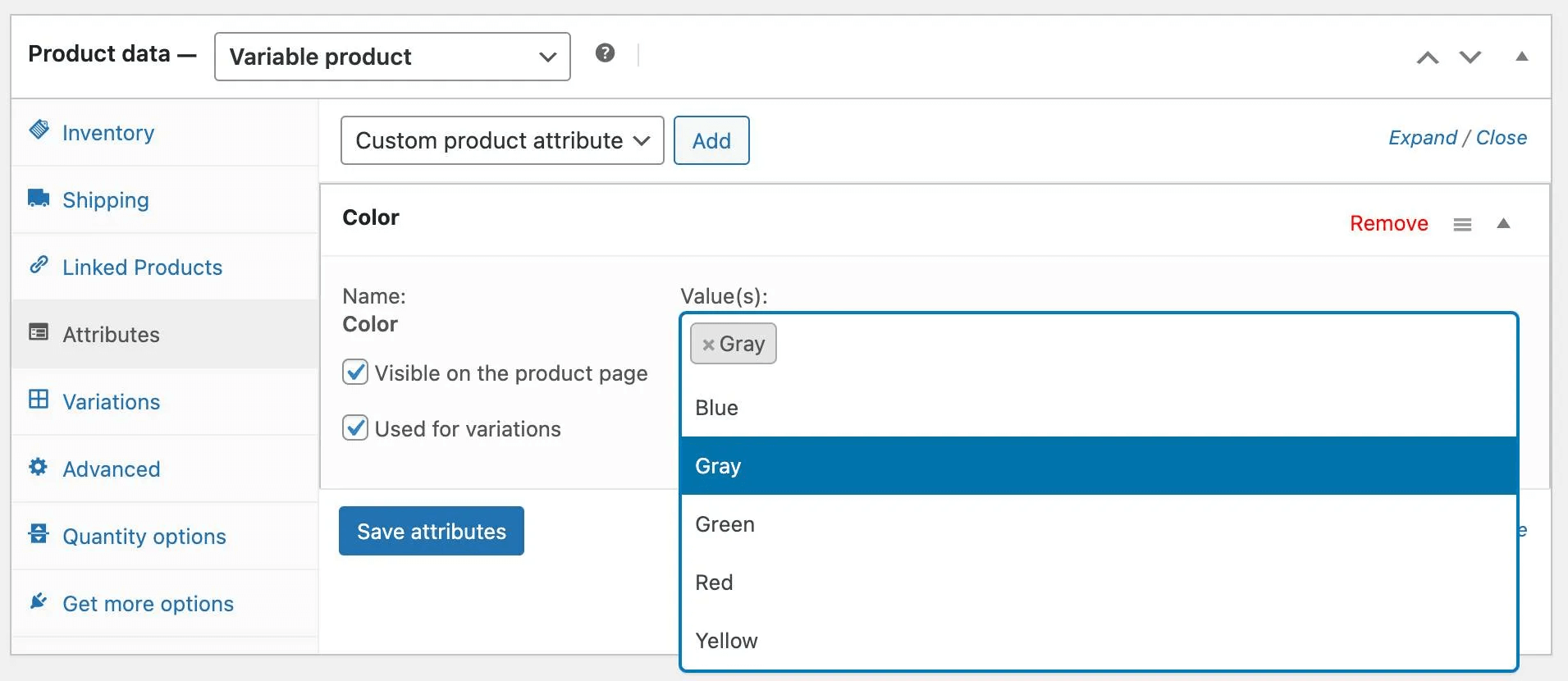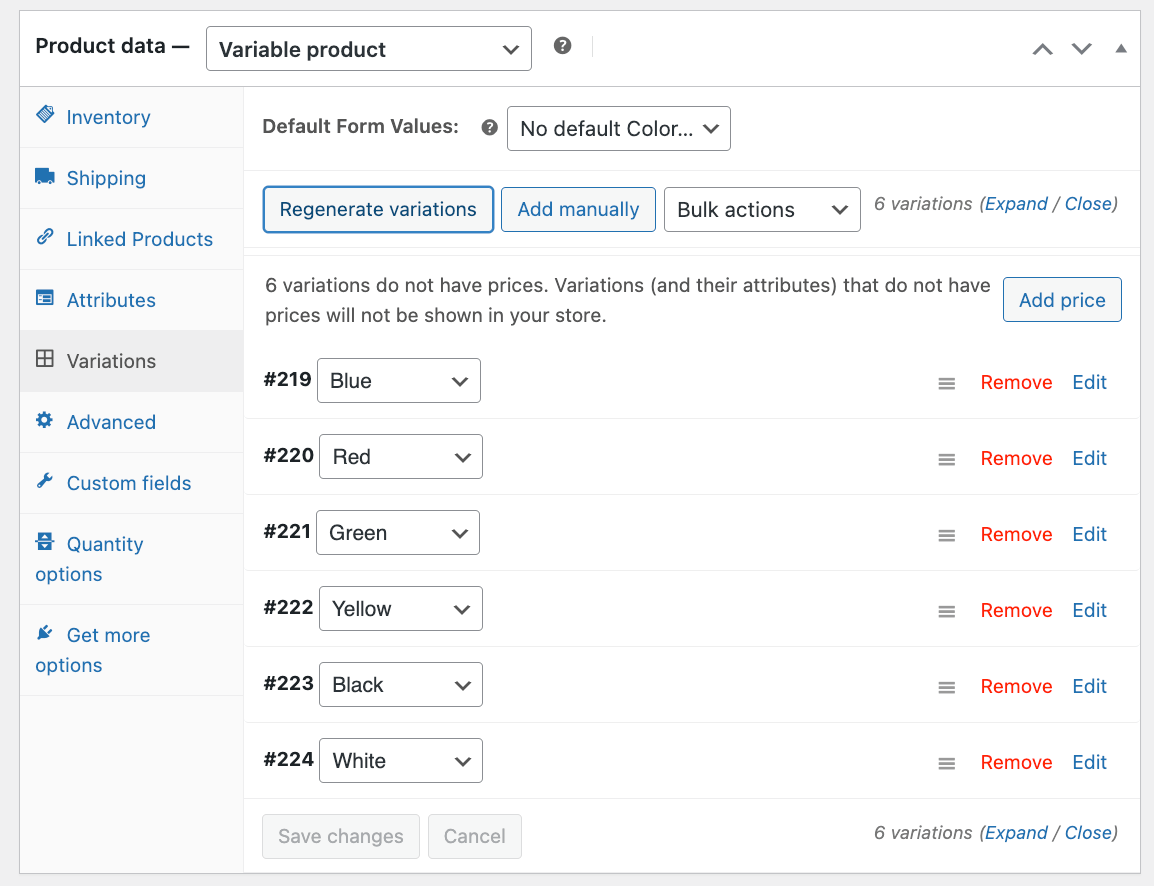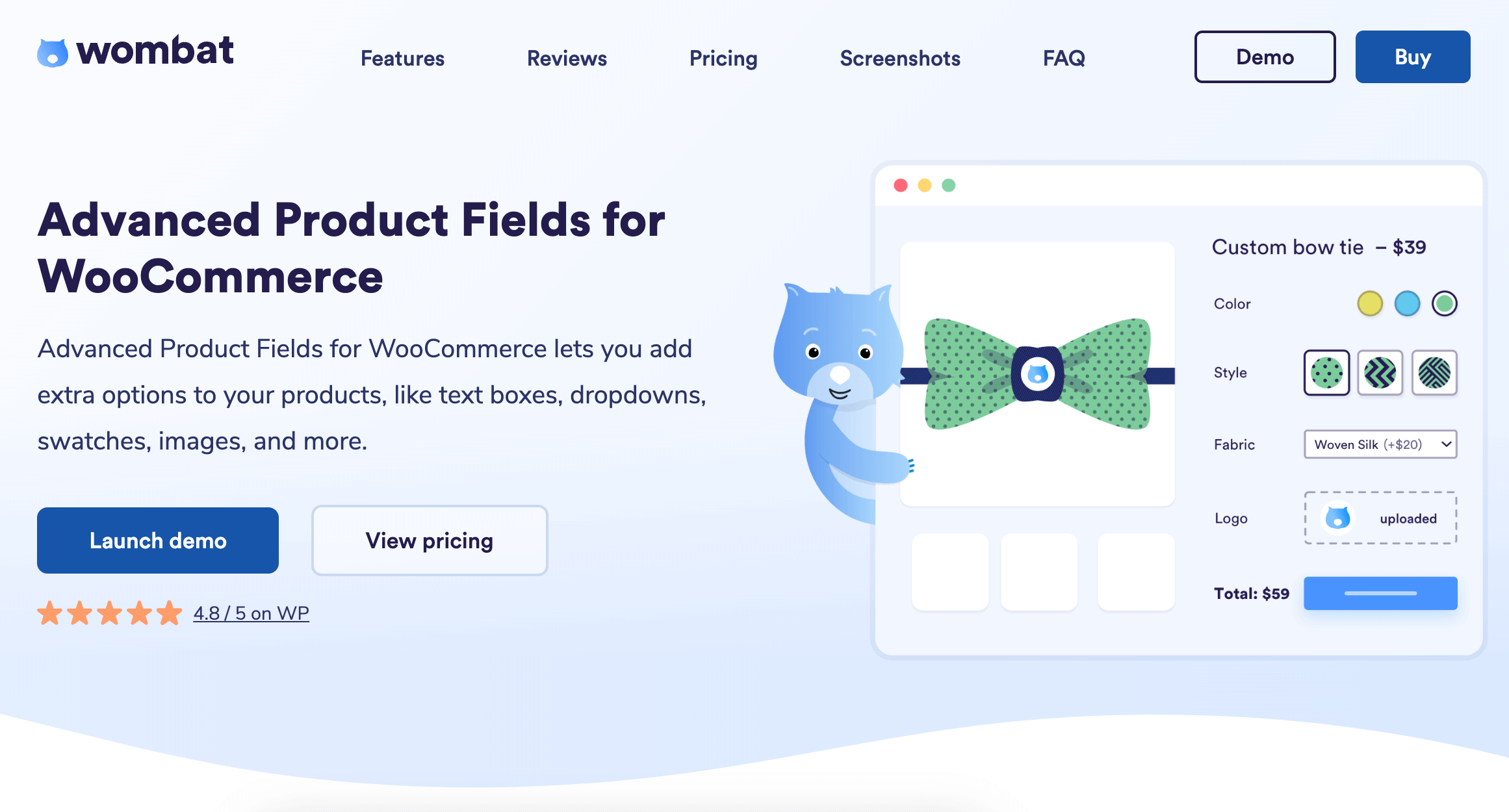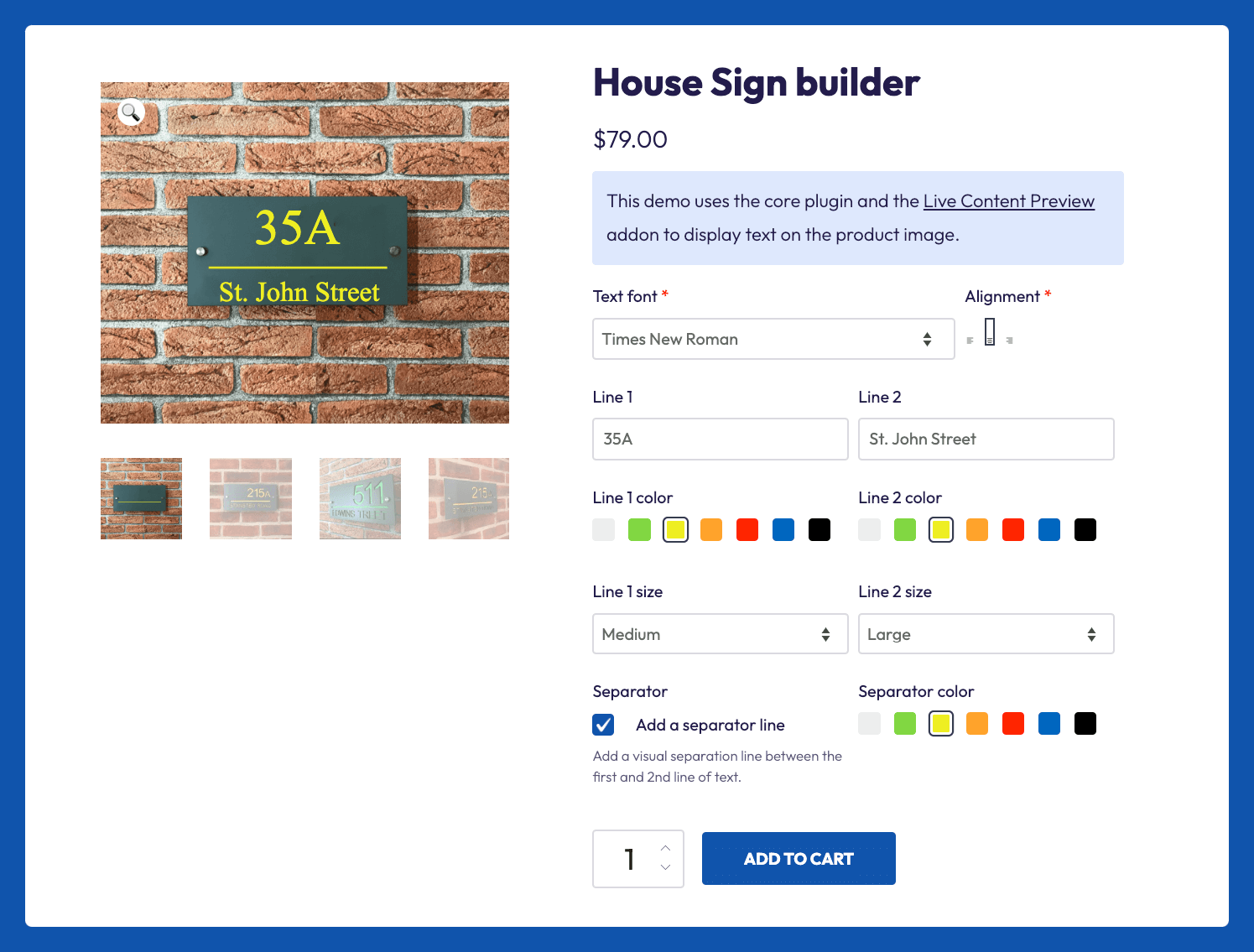Picture this: A customer lands on your product page, ready to buy. They love your design, but need it in blue instead of red. Or they want a large instead of a medium.
Without variable products, you’d lose that sale.
This is where WooCommerce comes in with its versatile capability to create variable products – multi-dimensional products that have different attributes like size, color, or material, giving your customers the liberty to choose what best suits their preferences.
Now, while the platform does include basic variable product functionality out of the box, the default setup only gives you dropdown menus. No visual swatches, custom options, or dynamic pricing beyond the basics.
So, how do you utilize variable products in WooCommerce? The key is to get a plugin that can manage product variations.
Let’s dive further into WooCommerce variable products – from setting them up to utilizing them to the fullest, with Advanced Product Fields for WooCommerce.
What is a variable product in WooCommerce?

WooCommerce variable products allow customers to choose from multiple variations like different colors, sizes, or materials before purchasing. Customers select their desired combination when purchasing, and each variation can have different pricing, stock levels, and product images.
Here are the core aspects that define variable products:
- Attributes: Characteristics that define variations (color, size, material).
- Variations: Specific combinations customers select (small red, medium blue, large black).
- Inventory management: Individual stock control for each variation.
- Pricing: Different prices for each variation.
Suppose you’re selling a T-shirt that’s available in various colors like red, blue, and black.
- Here, the T-shirt itself is the variable product.
- The different colors signify the attributes, and each color variant of the T-shirt represents a product variation.

Variable products aren’t limited to physical attributes like color, size, or material. They can also include products with customization or personalization options.
For instance, you could offer the same T-shirt with an option to add custom text or images. This adds a layer of personalization that makes the product more than just a purchase – it becomes an expression of the customer’s personality.
Understanding attributes vs variations
Attributes define product characteristics like color or size, while variations are specific combinations that customers can purchase. Each variation can have unique data, including custom pricing, individual SKUs for inventory tracking, separate stock management, and variation-specific images.
Simple products have no variations, and variable products offer multiple options.
Let’s make this crystal clear with a comparison table:
| Component | What it is | Example |
|---|---|---|
| Simple product | One product, one option | Basic white mug – $10 |
| Variable product | One product, multiple options | Coffee mug with choices |
| Attribute | The characteristic you can change | Color, size, material |
| Variation | The specific combination for sale | Large blue ceramic mug – $15 |
How attributes create variations
Think of attributes as the building blocks of your variations.
One attribute example:
- Product: Baseball cap
- Attribute: Color (red, blue, black)
- Result: 3 variations
Multiple attributes example:
- Product: Hoodie
- Attribute 1: Size (S, M, L, XL)
- Attribute 2: Color (gray, navy)
- Result: 8 variations (4 sizes × 2 colors)
Important: Each variation gets its own “Add to Cart” data. This means you can set different prices, manage separate inventory, and even use unique product images for every single combination.
What makes each variation unique?
Every variation can have its own:
- SKU: Track inventory separately for each option
- Price: Charge more for premium materials or larger sizes
- Stock status: Show “out of stock” for popular options while others remain available
- Weight & dimensions: Important for accurate shipping calculations
- Product image: Display the exact item customers will receive
WooCommerce automatically generates all possible combinations when you set up attributes. If you add 3 colors and 4 sizes, you’ll get 12 variations created instantly.
This flexibility is what makes variable products perfect for stores selling:
- Apparel (sizes and colors)
- Printed products (paper types and sizes)
- Furniture (materials and dimensions)
- Electronics (storage capacity and colors)
- Subscription boxes (frequency and size options)
Benefits of WooCommerce variable products
Variable products deliver four key business advantages:
- Customer experience: Enables product customization and choice flexibility.
- Sales conversion: Increases purchases by catering to different preferences.
- Bounce rate: Reduces customer departure by offering suitable options.
- Order value: Creates opportunities for premium pricing on customizations.
Customer experience improvements
Variable products let customers tailor products to their exact needs. Shoppers can select their preferred size, color, material, or style without leaving the product page.
This personalization transforms a standard purchase into a custom shopping experience.
Real impact: A clothing store offering size and color variations keeps customers engaged on one page instead of browsing through multiple separate products.
Higher sales conversion rates
Variable products capture more sales by accommodating different customer preferences.
When shoppers find exactly what they want, they buy. No more “almost perfect” products that customers abandon.
Consider this scenario:
- Customer wants a blue laptop bag.
- You only show black options.
- Customer leaves to shop elsewhere.
- Lost sale.
With variable products:
- Customer selects blue from color options.
- Adds to cart immediately.
- Completed purchase.
Reduced bounce rates
Customers stay on your site when they can customize products to match their needs.
Variable products eliminate the frustration of browsing multiple pages for the right option, as everything is consolidated on one page.
| Without variable products | With variable products |
|---|---|
| Customer clicks through 5 product pages | Customer stays on 1 page |
| Can’t find the right combination | Selects exact preferences |
| Leaves the site frustrated | Completes purchase satisfied |
Increased average order value
Customization commands higher prices. Customers willingly pay more for products that match their exact specifications.
Variable products create natural upselling opportunities:
- Premium materials cost extra.
- Larger sizes carry higher prices.
- Custom options add value.
How to create and manage variable products
Creating variable products in WooCommerce can feel like piecing together a puzzle. However, with this step-by-step guide, you’ll have your product variations live and ready for eager customers in no time.
1. Create global attributes and define terms
Before you create variable products, you have to define the attributes that will form the variations.
- Navigate to Products → Attributes in the WordPress dashboard.
- Create global attributes that can be used across multiple products.
- Enter an attribute name like “Color” in the Name field.
- Click “Add attribute” to save.
- Define terms such as Red, Blue, and Black for the Color attribute.
- Each term represents one option customers can select.
In the example below, we’ve created attributes for Color, Size, and we’re adding a new one for Fabric.

2. Change simple products to variable products
- Go to Products → Add New to create a new product.
- Select Variable product in the Product data section.
- This enables the variation functionality for the product.
- The interface changes to show additional tabs for variations.

3. Add attributes to products and create variations
- Click the Attributes tab in the Product data section.
- Add previously created attributes to your product.
- Select “Color” from the dropdown menu.
- Choose which terms apply to this product.
- Check the “Used for variations” checkbox and click Save attributes.

- Navigate to the Variations tab.
- Select Generate variations.

- WooCommerce now automatically generates every variation.
- Once WooCommerce is finished, click the Add Price button to set a global price for each variation or open each variation individually and set a price.

4. Manage product data for different variations
Each variation can have unique pricing data, and you can set individual SKUs and stock status for each variation.
- Click the triangle icon next to each variation to expand the options.
- Upload separate images for each variation option.
- Enter the regular price for this specific variation.
- Add the SKU for inventory tracking.
- Set stock quantity if managing inventory.
- Upload an image showing this exact variation.
- Configure weight and dimensions for shipping calculations.
What are the limitations of the default WooCommerce variable products?
While the steps above equip you to create variable products with predefined options, they have some limitations:
- Your variations are only displayed as a basic dropdown list, making product discovery less intuitive for customers who prefer visually engaging options.
- Attributes are always “choice options”, meaning the user has to click a choice. They do not allow any “free input” like text input fields would do.
- Each variation (a combination of options) has 1 fixed price. You can not simply add a price on top of the base product price.
Introducing Advanced Product Fields for WooCommerce
To overcome the limitations of default WooCommerce variable products and to offer a more dynamic and personalized shopping experience, the Advanced Product Fields for WooCommerce (APF) plugin comes into play.

This powerful plugin is designed to enhance your variable products, providing a range of features that make customization and management easier and more effective.
In essence, APF allows you to create forms for your product pages, which customers can fill out before adding the product to cart. Those product options will be part of their order and can even influence the final price of the product!
Here are some of the key features that make Advanced Product Fields the go-to solution for maximizing the potential of your variable products:
- Customizable input fields: With 16 different input field types to choose from, you can offer a wide range of options for product customization – way more than just dropdown options. This includes text boxes, select menus, cards, checkboxes, radio buttons, file upload, date pickers, and more!
- Global field creation: This feature makes managing your variable products a breeze. You can easily add and update customization and variation display options for your variable products in bulk, saving you time and ensuring consistency across your store.
- Powerful display options: Advanced Product Fields allows you to optimize how your variable product pages are displayed. You can change the main product image based on selections the customer has made, show or hide extra input fields using conditional logic, and update the final product price dynamically as the customer makes changes.

If you want to learn more about this, please select one of the following options:

Easily power-up your variable products in WooCommerce with additional field types and display options!
Find out moreQuick reference guide
Key terminology
- Attribute: Product characteristic (color, size, material)
- Variation: Specific combination (small red shirt)
- Variable product: Product with multiple variations
- Simple product: Product with no variations
- Parent product: The main variable product containing all variations
- Attribute term: Individual option within an attribute (red, blue, green)
- Global attribute: Reusable attribute across multiple products (created via WooCommerce → Attributes)
- Local attribute: Attribute specific to one product only
- Default variation: Pre-selected option when page loads
- Variation ID: Unique identifier for each variation
- Attribute slug: URL-friendly version of attribute name
- Variable product type: Product data setting that enables variations
Troubleshooting checklist
| Type of problem | Example | Solution |
|---|---|---|
| Display issues | Variations not showing on frontend | Check ‘Used for variations’ checkbox, save attributes before generating, refresh page. Make sure the variations have a price set as well. |
| Pricing problems | Price shows as $0 or not updating | Set individual variation prices, clear sale prices |
| Image issues | Product image stays the same | Upload variation-specific images, clear browser cache, use JPG/PNG/WebP formats |
| Stock problems | Shows “Out of stock” incorrectly | Enable variation-level stock management, set quantities, check parent stock settings |
| Performance | Slow loading with many variations | Ideally, do not use more than 30 variations per product |
| Missing options | Some variations don’t appear | Regenerate variations, check attribute assignments, clear transients |
Quick wins for better variable products
- Order matters: List sizes small to large, colors alphabetically
- Set defaults: Pre-select your most popular variation
- Use consistent pricing: Similar variations should have logical price differences
- Preview before publishing: Test the customer experience
Did you know? You can bulk edit variations by selecting multiple items in the Variations tab and using the bulk actions dropdown.
Wrapping up
Offering variable products on your WooCommerce store opens up a huge amount of possibilities. It allows you to cater to a wider range of customer preferences, providing a more personalized and satisfying shopping experience.
The benefits are manifold – from improved customer experience and increased sales to reduced bounce rates and opportunities to increase the average order value.
However, to truly unlock the potential of variable products, a powerful tool like Advanced Product Fields for WooCommerce is indispensable.
With its customizable input fields, global field creation, powerful display options, and flexibility in adjusting products from the cart, it brings a new level to your WooCommerce store.
